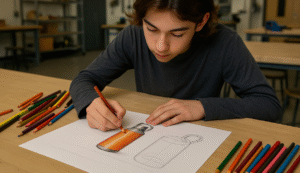 Amiria Gale
Amiria Gale
Different Types of Rendering Techniques in Drawing
Design and Technology students often have to render their drawings using graphite pencil, coloured pencil, marker pens, and other graphic mediums. This article provides an introduction to rendering to help students create drawings that accurately represent material, surface texture, and 3D form. What is rendering? Rendering means to apply tone or “shading” (light and shadow) … Read more
Isometric Drawing: examples for beginners
High school Design and Technology students are often required to understand, interpret, and draw in isometric, including isometric circles, arcs, and other curves. This article provides an introduction to isometric to help students excel. Isometric is: How to draw an isometric circle How to draw an isometric circle by plotting points Note: this method is … Read more
Planometric Drawing: examples and definitions for students
Planometric is a drawing method where the plan (view from above) is inclined at 45° × 45° (or sometimes 60° × 30°). [understand and draw planometric views at 45° × 45° and 60° × 30°, including circles and arcs (scaling is not required) – IG] [planometric drawings (45/45).] [Coming soon]
Easy Perspective Drawing for Beginners: step-by-step guide for students
Please see a comprehensive guide to one point perspective on our sister site, the Student Art Guide. One point perspective can also be used as a method to enlarge or reduce a shape. [understand and draw estimated perspective, using one-point and two-point starts and perspective grids – IG] [coming soon]
What is a Sectional View? Definitions and Examples of Sectional Drawings for Students
Sectional drawings show what an object looks like as if it had been cut open or sliced through. Sections: Hatching guidelines [select the most suitable section and draw whole, part, revolved and removed sections – IG] including an understanding of how to hatch cut surfaces, nut and bolt conventions [coming soon]
What is an Exploded Drawing? Definitions and Examples for Students
Many high school Design and Technology students are required to draw exploded drawings, which show components ‘pulled apart,’ so you can see how the items fit together. An exploded drawing may be a formal isometric drawing or orthographic drawing completed using the drawing board or a freehand sketch. Guidelines for exploded drawings: Note: You must … Read more
Freehand Sketching for Beginners: Tips for Design and Technology Students
Use a crating drawing technique
What is the Difference Between Style, Fashion, Trends, and a Fad?
Designers must understand the impact of fashion, trends, and fads upon designed products. This article introduces students to these terms and discusses the impact of fashion and style upon product design. Fashion Fad Trend Style Fashions can fade – style is eternal. Style can refer to a formal art & design style, or an individual’s … Read more
Cultural & Social Factors Affecting Consumer Behaviour & Product Design
A product can impact society in numerous ways. This influence can be positive or negative and these impacts may differ across individuals, groups, and cultures. Social considerations in product design include factors such as accessibility for different age groups and abilities, cultural sensitivities around symbols and colors, language and communication preferences, religious observances and restrictions, … Read more
